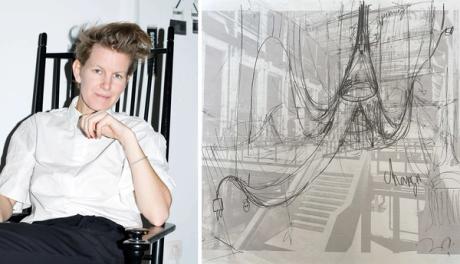
Laure Prouvost is known for her work examining human interconnectedness with nature. Her most notable projects include her Turner Prize-winning Wantee (2013), a film about a delightful journey in search of a fictional grandfather, and her work for the French pavilion at the 2019 Venice Biennale, the octopus-inspired installation Deep See Blue Surrounding You.
Now the French-born, Brussels-based, video and installation artist has been commissioned by the future-facing Berlin-based LAS Art Foundation to produce a new work at the cutting edge of computing technology. Prouvost’s We Felt a Star Dying—a plant-like installation made in collaboration with the philosopher Tobias Rees and the Google Quantum AI team, and large enough to fill the vast central hall of Kraftwerk in Berlin—goes on show on 20 February.
“Artificial intelligence has already become established in our society and quantum computing is expected to follow in the coming years,” Bettina Kames, the chief executive officer of the LAS Art Foundation, said in an announcement statement. “As quantum technology is due to enact profound change in our world, LAS believes it is vital and urgent to think through its implications with artists. With her visionary approach, Laure Prouvost is expanding perspectives and opening up the subject to many for the first time.”
Prouvost tells The Art Newspaper that the experience of working with the Google team has been “incredibly fascinating in terms of re-switching the way one might think of something”. For her, part of the beauty of the project has been working with the quantum computer to distil, or translate, the “quantum essence” of texts and images—at the subatomic level that underlies everything in nature. She has then captured that essence in her installation, which comprises physical materials as well as audio and video. The collaboration has also inspired her to see a new oneness in her vision of technology, society and nature.
Prouvost has previous experience working at “quantum” level—the fundamental, subatomic, levels at which nature functions— she says, from her time as assistant to the maverick London-based conceptual artist John Latham in the early 2000s. She explains that Latham “always had a sense of translating… [the] scientific world in his body of work, saying that art is quantum”. He had, she adds, a particular fascination with what he called the “least event”—the smallest calculable fractions of time, which epitomised his concern with a time- rather than space-based approach to art.
Quantum computing: the next frontier
Quantum computing is the next great technological frontier, with nation states and the tech giants—IBM, Google, Microsoft—heavily engaged (and invested) in moving through the experimental stages to a working everyday model of a quantum computer. Set up on principles completely different to today’s “classical” computers, quantum computers—running at the “quantum” scale of the components that make up atoms—can run calculations on certain tasks exponentially faster even than existing supercomputers.
The announcement of Prouvost’s commission comes a day after her collaborators at Google Quantum AI, a group led by Hartmut Neven and based in Santa Barbara, California, announced a new quantum computing chip, Willow. It is seen as another landmark moment bringing ever closer the prospect—perhaps now just a few years away—of quantum computers being robust enough to form part of daily life.
The headline-grabbing statistic about Willow, published in Nature magazine, is that it takes five minutes to complete some tasks that the world’s fastest conventional computers would take 10,000,000,000,000,000,000,000,000 years to complete, a timespan that far exceeds the age of the known universe.
The second, and no less telling finding for the advent of quantum computing is that it promises to introduce a new robustness in error-correcting—one of the great challenges in quantum computing. This will, it is said, help quantum computing to deliver its theoretical potential in speeding up medical research (by modelling long chains of molecules), finally cracking nuclear fusion (the holy grail of clean energy) and helping humanity make the most of new materials including new battery technology.
Quantum computing’s geopolitical value also lies in its potential to break the most advanced codes, including those that protect the functioning of the internet and of the blockchain and cryptocurrencies—the US has passed a series of laws since 2022 to get businesses to move over to “quantum-safe” encryption. “Willow brings us closer to running practical, commercially-relevant algorithms that can’t be replicated on conventional computers,” Neven said in an announcement blogpost.
Elon Musk, the founder of SpaceX and the owner of the social media platform X, who has thus far pronounced relatively rarely on the potential of quantum computing, was moved to pronounce “Wow” at the news of Willow, in an exchange on X with Sundar Pichai, the chief executive officer of Google.
The quantum essence of things
“It’s a big, big experiment about what this kind of next generation of computers can bring in terms of aesthetics and visual languages and sound,“ Kames tells The Art Newspaper of the collaboration with Prouvost and Google. “So it’s really groundbreaking.” The team in California has “run moving image and sounds on quantum circuits… something that hasn’t been done [before].” Kames, who visited the team in Santa Barbara with Prouvost, says.
LAS has been in conversation with Prouvost on the new piece for the past five years, from soon after the artist’s appearance at the 2019 Venice Biennale, with the conversations intensifying over the past two years.
The collaboration with Prouvost is the first of a three-part “quantum art initiative” that LAS is running, during what the United Nations has proclaimed as the International Year of Quantum Science and Technology (IYQ). The occasion comes a century after scientists such as Walter Heisenberg and Nils Bohr established the principles of quantum mechanics.
LAS wants, Kames says, to start “the discourse in society about quantum. I think everyone has understood that AI is important and has an impact on our lives and will change our futures. Not so much with quantum yet.”










